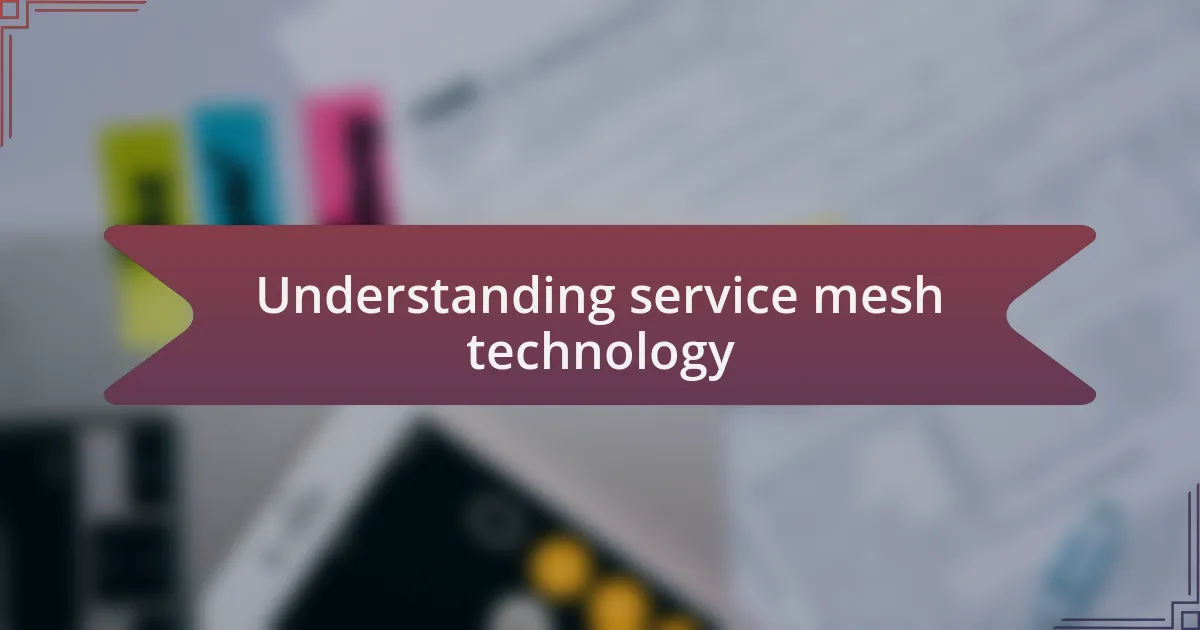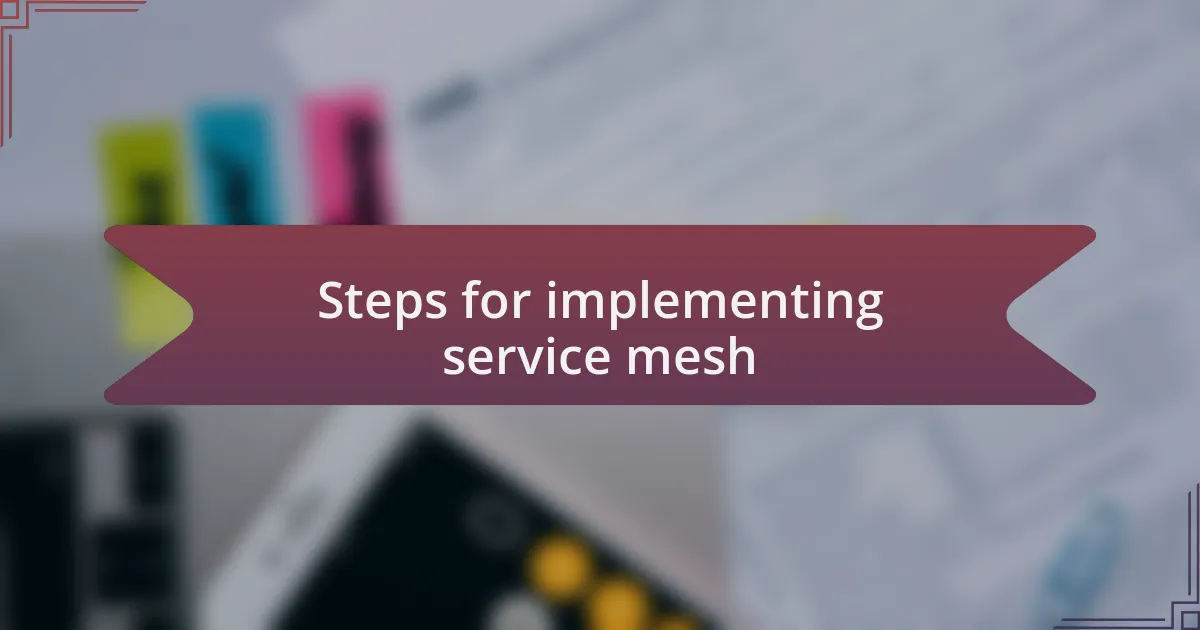Key takeaways:
- Service mesh technology improves service-to-service communication in microservices by managing security, load balancing, and observability.
- The control plane handles routing and service discovery while the data plane manages communication tasks through deployed proxies.
- Implementing a service mesh requires careful assessment of existing architecture, and selecting the right technology is crucial for successful integration.
- Prioritizing observability and engaging with community support can significantly enhance troubleshooting and implementation experiences.

Understanding service mesh technology
Service mesh technology is essentially a dedicated infrastructure layer designed to manage service-to-service communication within microservices architectures. From my experience, it acts like a traffic controller that ensures these services can interact seamlessly, handling challenges like security, load balancing, and observability. I remember the first time I set up a service mesh; it felt like unlocking a new dimension of control over my application’s interactions.
Imagine being able to monitor every request flowing between services without diving deep into the application code. That’s the beauty of a service mesh—it abstracts complexity and gives developers peace of mind. I felt a weight lift as I began to see real-time metrics on latency and errors. It was illuminating!
The concept may seem daunting at first, but I often remind myself that the learning curve is worth the profound benefits it brings. Have I ever struggled with troubleshooting? Absolutely! But with proper service mesh implementation, I found that issues became traceable, making it easier to pinpoint bottlenecks. This realization solidified my belief in the value of adopting service mesh technologies for scalable applications.

Key components of service mesh
When I think about the key components of a service mesh, the control plane immediately comes to mind. This is where decisions are made about routing, policy enforcement, and service discovery. In practical terms, it feels like being the conductor of a symphony, guiding the way different services interact and ensuring that everything harmonizes perfectly. Have you ever found yourself overwhelmed by how many services your application manages? I certainly have, and that’s where the control plane truly shines, simplifying the chaos.
Another essential part of a service mesh is the data plane, which consists of the proxies deployed alongside each service. These proxies handle the actual communication tasks, like load balancing and retries. I remember feeling a sense of relief when I realized these elements operated independently of my business logic, allowing me to focus on building features instead of worrying about how different services talk to each other. Isn’t it both exciting and liberating to let technology take on some of that burden?
Lastly, observability tools are crucial for gaining insights into the interactions between services. I vividly recall the first time I used distributed tracing; it was like turning on a floodlight in a dark room. Suddenly, I could see exactly where latencies were occurring, allowing me to respond quickly to potential issues. Isn’t it fascinating how such visibility can transform our approach to debugging and performance tuning? The marriage of these components enhances not only the performance of applications but also our confidence as developers.

Steps for implementing service mesh
Implementing a service mesh begins with assessing your existing architecture. In my experience, taking the time to map out all the services and their interactions upfront pays off. Have you ever tried to navigate a complex network without a clear map? I certainly have, and it can feel disorienting. By carefully outlining dependencies, you set the groundwork for a successful deployment.
Next, selecting the right service mesh technology is critical. With so many options out there, it’s easy to feel like a kid in a candy store. I remember spending countless hours comparing features and capabilities before landing on a solution that aligned with my specific needs. Don’t rush this step; the right choice can streamline everything from traffic management to observability later on.
Once you’ve made your selection, it’s time to progressively roll out the service mesh. Implementing it one service at a time can be less daunting. I found it incredibly reassuring to start small, gradually integrating the mesh into my applications. It felt like taking small bites of a delicious meal rather than overwhelming myself all at once. How comforting is it to know that you can build your confidence as you go, ensuring smooth transitions and establishing best practices along the way?

Lessons learned from my implementations
Implementing a service mesh taught me the importance of patience and meticulous planning. During one of my initial projects, I rushed the deployment and quickly learned that shortcuts lead to unforeseen complications. Have you ever dove into a task only to realize later that you missed a crucial step? I certainly felt that sting, and it reinforced the value of thorough documentation and communication among teams.
Another crucial lesson was the significance of observability. In a previous implementation, I considered it a secondary concern, which resulted in headaches down the line when troubleshooting issues. I vividly remember days spent sifting through logs and configurations, feeling like I was searching for a needle in a haystack. By prioritizing observability from the start, I could have saved myself hours of frustration and gained better insights into performance metrics.
Lastly, I discovered the power of community support. When I faced challenges, reaching out to online forums and local meetups provided not just answers, but also encouragement. It was comforting to know others had faced similar hurdles and emerged on the other side. How valuable is it to share experiences and learn from one another? Embracing this collaborative spirit has been an essential part of my journey in navigating service mesh implementations.